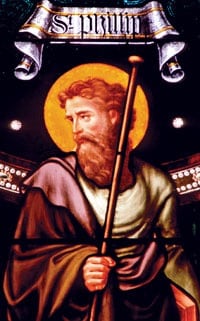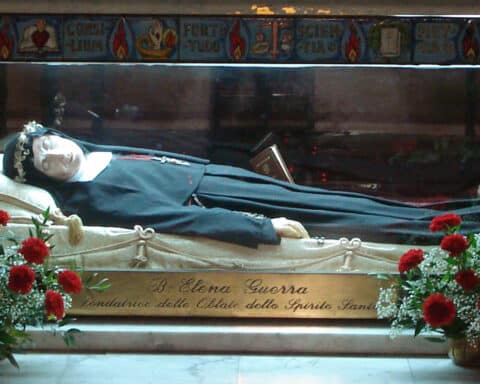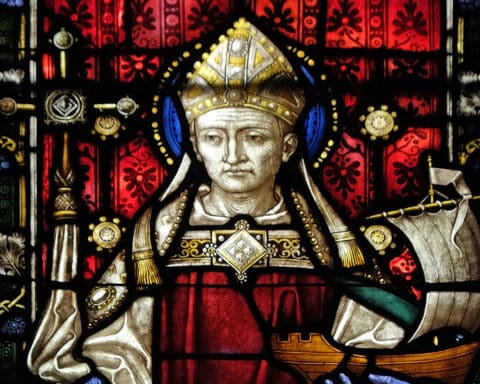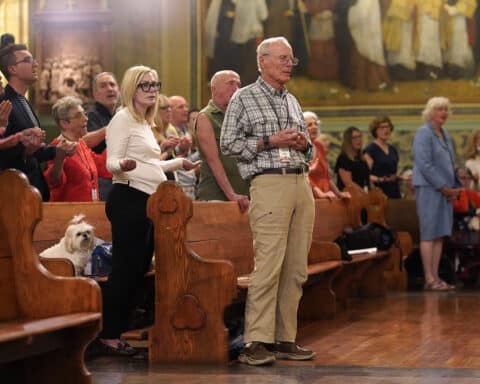In July, archaeologists working in Turkey announced that they had discovered what they believed to be the tomb of the apostle St. Philip. The octagonal tomb was found on Martyr’s Hill near the ruins of a fifth-century church dedicated to St. Philip. According to a tradition recorded in the apocryphal fourth-century document known as the Acts of Philip, around the year 80 the apostle was arrested in Hierapolis, nailed by his feet to a tree, upside down, and ultimately beheaded.
The site of St. Philip’s grave became a destination for Christian pilgrims, and the archaeologists even uncovered the broad road that led to the martyrium, or martyr’s shrine. The shrine was destroyed in the seventh century by a violent earthquake and fire, after which the relics of St. Philip were transferred to Constantinople (modern Istanbul) and then to Rome where they were enshrined with the relics of St. James the Lesser in the Church of the Twelve Apostles.
The relics of Sts. Philip and James are still venerated in the crypt of the Twelve Apostles. The archaeologists have not yet opened the tomb in the Hierapolis martyrium; if human bones are found in the tomb, it would raise the question of who is buried in the crypt of the Twelve Apostles.
St. Peter
Before the discovery of St. Philip’s tomb, we were certain of the burial places of only three apostles: St. Peter and St. Paul in Rome and St. John in Ephesus.
Around the year 64, St. Peter was crucified head-downward in the Circus, or arena, of Nero on the Vatican Hill. Christians recovered his body and buried it in a nearby cemetery. Around the year 326 the Emperor Constantine erected a large basilica on the Vatican Hill, with the high altar positioned above St. Peter’s grave. But over succeeding centuries the location of the grave became forgotten.
In 1939 workmen were digging a grave for Pope Pius XI in the grottoes under St. Peter’s when one of them felt his shovel cut into a void rather than dirt. Shining a flashlight through the hole, the work crew saw the interior of a second-century mausoleum. Further exploration revealed an entire Roman necropolis, covered by Constantine and perfectly preserved. Directly beneath the high altar of St. Peter’s, archaeologists found a simple tomb containing the bones of a robust elderly man. Scratched into the tomb wall were countless prayers and petitions to St. Peter, as well as the inscription, “Peter is within.” After years of study, Pope Paul VI declared in 1968 that the bones in that tomb were those of St. Peter.
St. Paul
According to tradition, St. Paul was beheaded the same day St. Peter was crucified. Constantine built a basilica over the apostle’s grave on the Via Ostia.
In 2009, Pope Benedict XVI announced that after several years of study, Vatican archaeologists felt confident that the remains enshrined in a sarcophagus beneath the high altar of Rome’s Basilica of St. Paul Outside-the-Walls are indeed the relics of St. Paul.
The pope was quoted as saying, “Small fragments of bone were carbon dated by experts who knew nothing about their provenance and results showed they were from someone who lived between the first and second century. This seems to confirm the unanimous and uncontested tradition that these are the mortal remains of Paul the Apostle.”
St. John
St. John the Evangelist died in Ephesus around the year 100. After 313, when Emperor Constantine ended anti-Christian persecution in the Roman Empire, Ephesian Christians built a chapel over the apostle’s tomb.
In the fifth century, Emperor Justinian replaced the chapel with a grand basilica. After the area was conquered by the Turks, the basilica was converted to a mosque, which in turn was destroyed by Tamerlane in 1402. Archaeologists have found St. John’s grave inside the ruined basilica, but it is empty and no one knows what became of his body.
St. Andrew
St. Andrew, the first of the apostles and St. Peter’s brother, was martyred in Patras, Greece. Local Christians buried him there, but most of his bones were later moved to Constantinople. In 1206 Italian Crusaders looted the church in Constantinople and carried St. Andrew’s relics to Amalfi, Italy, where they remain to this day.
Legend claims that in the fourth century a Greek monk, St. Regulus, or Rule, arrived in Scotland with a few of St. Andrew’s bones. He built a chapel for the relics; a town sprang up around the chapel and took the name St. Andrews. The apostle became the patron saint of Scotland, and his shrine was a destination for pilgrims until 1559 when Protestant extremists burned the saint’s relics. When the Catholic hierarchy was restored in Scotland in 1878, the following year the archbishop of Amalfi presented Archbishop John Strain of Edinburgh with a large piece of St. Andrew’s shoulder bone. In 1969 Paul VI presented Cardinal Gordon Joseph Gray with another relic of St. Andrew. The two relics are kept in St. Mary’s Cathedral in Edinburgh, in a chapel known as Scotland’s National Shrine of St. Andrew.
The two Sts. Jameses
In the year 44 St. James the Greater, brother of St. John, was martyred in Jerusalem — the first of the apostles to give his life for the Catholic faith. According to tradition, his body was miraculously transported to northern Spain and buried in a Christian cemetery. It lay there, forgotten, until 814 when a hermit named Pelayo followed a star out to an open field and uncovered the apostle’s relics.
Today they are enshrined in the magnificent Cathedral of St. James in Santiago de Compostela in Spain. Interestingly, beneath the cathedral archaeologists have found a first-century Christian cemetery.
St. James the Less served as the first bishop of Jerusalem and was martyred there: He was thrown from the roof of the temple and then, because he was still alive, stoned to death. According to tradition, James was buried on the Mount of Olives, overlooking Jerusalem.
In the sixth century, Emperor Justinian II moved his relics to Constantinople. At some point, a portion or perhaps all of St. James’ relics were moved to the Church of the Twelve Apostles in Rome, where today they lie in the same shrine with the relics of St. Philip.
St. Thomas
Ancient tradition tells us that St. Thomas traveled farther than any of the other apostles, preaching the gospel in India, where he was martyred by a Hindu priest who ran him through with a spear. A portion of St. Thomas’ bones are venerated in the Basilica of the National Shrine of St. Thomas in Chennai, India. Since 1258, the rest lie in a golden casket within a white marble altar in the Basilica of St. Thomas the Apostle in Ortona, Italy.
St. Bartholomew
We are told that after Pentecost, St. Bartholomew (also known as Nathanael) carried Christianity to Armenia, where he was martyred by being flayed alive. In 809 the relics of St. Bartholomew were moved from his tomb in Armenia to Lipari and then in 838 to Benevento in southern Italy. In 983 the Holy Roman Emperor, Otto III, erected a church in Rome on Tiberina Island in the Tiber River; he dedicated the church to St. Bartholomew and had a portion of the apostle’s relics enshrined there.
St. Matthew
The tax collector who became an evangelist, St. Matthew is said have preached in Ethiopia, where he was martyred as he said Mass. In 954, the relics of St. Matthew were translated from their tomb in Ethiopia to the city of Salerno in Italy. The relics are venerated in the crypt of Salerno’s Cathedral of St. Matthew.
Sts. Simon and Jude
The relics of Sts. Simon and Jude rest together beneath the altar of St. Joseph in St. Peter’s Basilica in Rome. Both apostles traveled together to preach the gospel in Persia, and both were martyred there: Jude was beaten to death with a club, and Simon was sawed in half. It is uncertain when their relics were transferred to Rome.
St. Matthias
The 11 surviving apostles chose St. Matthias to replace Judas, who betrayed Our Lord, then despaired and hanged himself. It is said that about the year 326 the empress St. Helena found St. Matthias’ grave in Jerusalem and sent his relics to the Christians of Trier, Germany. They are still venerated in St. Matthias’ Basilica in Trier.
In the case of most of the apostles, we must rely on ancient oral traditions rather than documented facts concerning their burial places. That can be frustrating, but it is understandable: although the twelve Apostles are famous to us, in their own day they were poor, obscure men. So it is especially exciting when archaeologists can throw new light on the resting place of an apostle.





